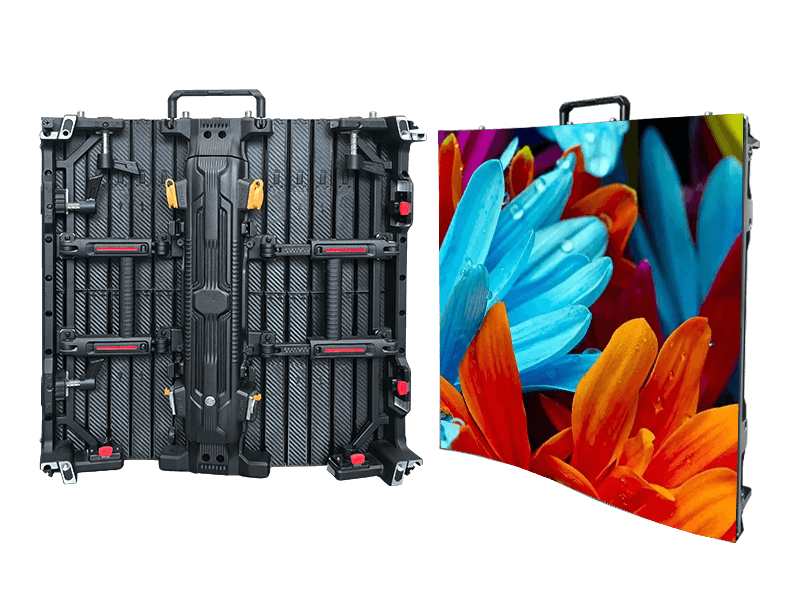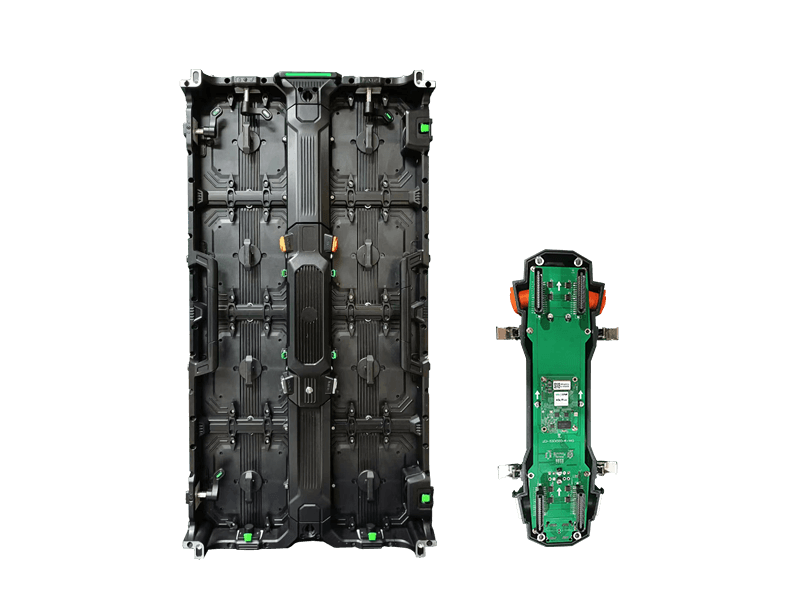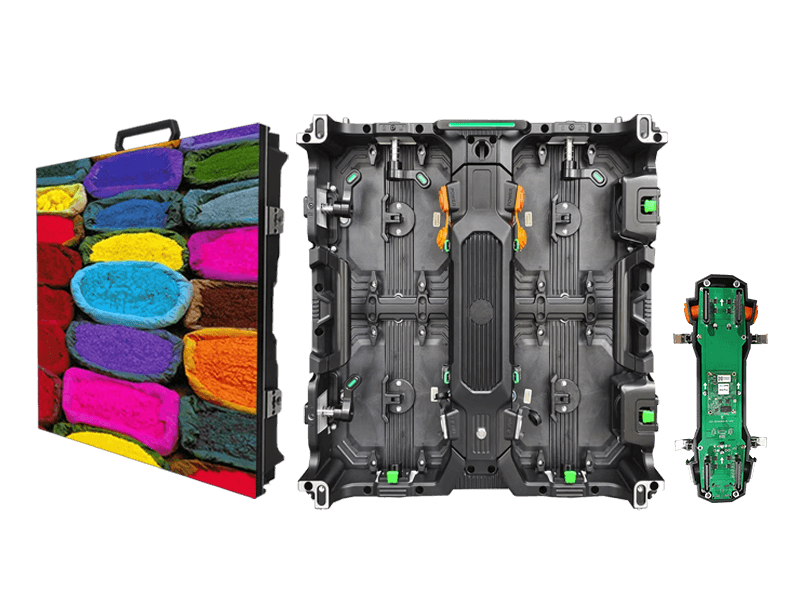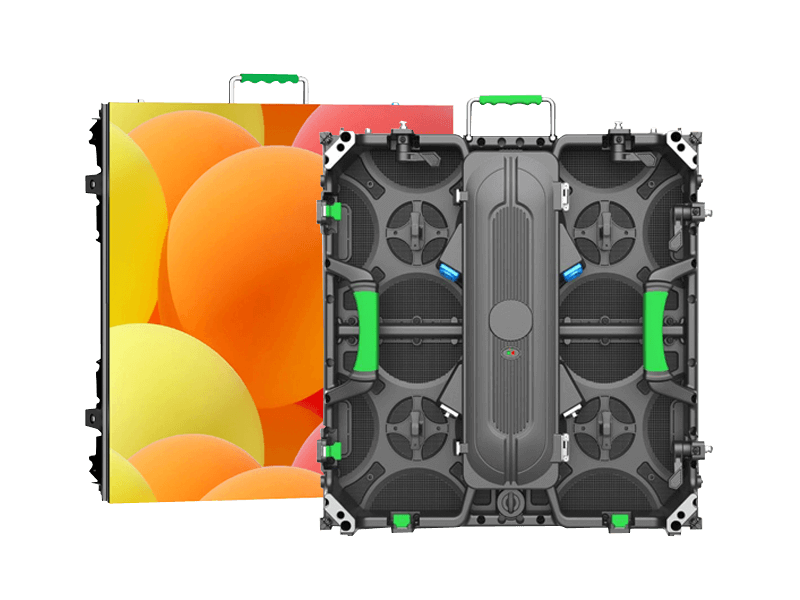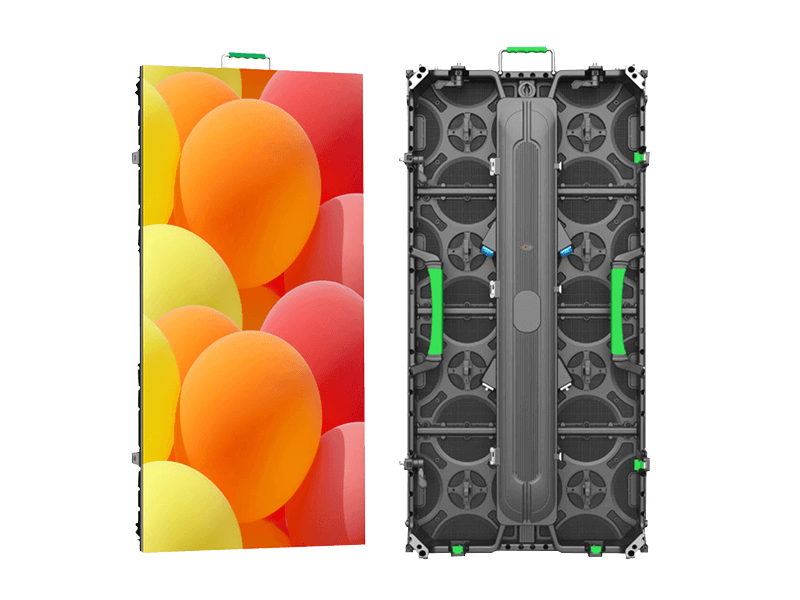LED Video Wall Package

Hot Products for LED Video Wall Package
Elevate your events with our premium LED Video Wall Package. Ready-to-use kits ensure quick installs, vibrant images, and reliable performance on any stage.
Become a distributor? Or need a quote?
LED Video Wall Package List
6×3m LED Video Wall Package
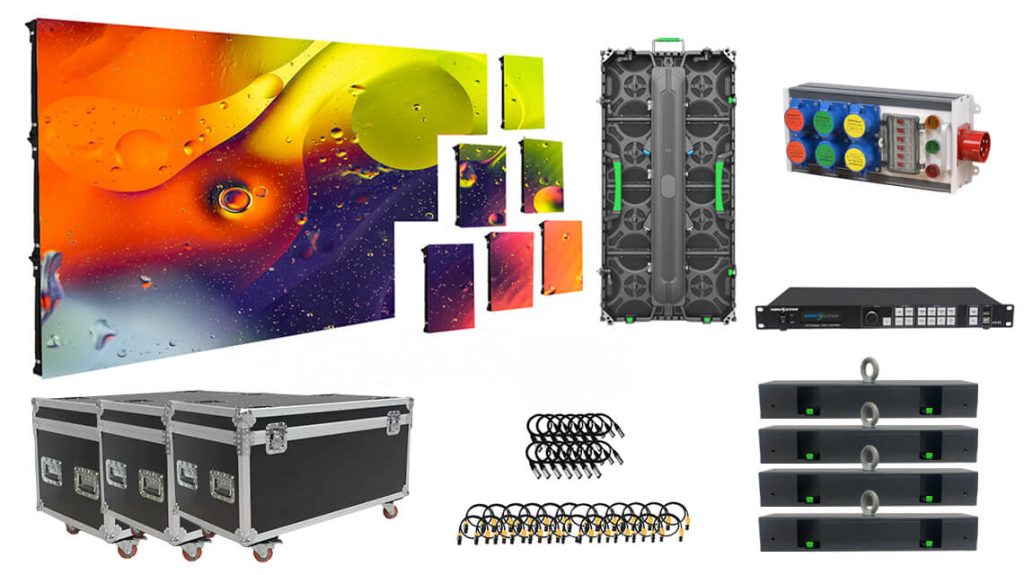
- (36) LED panel
- (1) Video processor
- (1) Distribution cabinet
- (12) Hanging bar
- (36) Power jumper cable
- (36) Network cable
- (6) Main power cable
- (2) Main network cable
- (15) Spare module
- (4) Spare power supply
- (7) Flight case
5×3m LED Video Wall Package

- (30) LED panel
- (1) Video processor
- (1) Distribution cabinet
- (10) Hanging bar
- (30) Power jumper cable
- (30) Network cable
- (6) Main power cable
- (2) Main network cable
- (12) Spare module
- (3) Spare power supply
- (6) Flight case
4×2m LED Video Wall Package

- (16) LED panel
- (1) Video processor
- (1) Distribution cabinet
- (8) Hanging bar
- (16) Power jumper cable
- (16) Network cable
- (2) Main power cable
- (1) Main network cable
- (7) Spare module
- (2) Spare power supply
- (3) Flight case
3×2m LED Video Wall Package

- (12) LED panel
- (1) Video processor
- (1) Distribution cabinet
- (6) Hanging bar
- (12) Power jumper cable
- (12) Network cable
- (2) Main power cable
- (1) Main network cable
- (5) Spare module
- (2) Spare power supply
- (3) Flight case
Other sizes can be customized
LED Video Wall Package for Rental Events | Complete LED Display Solutions by Singheng
Discover the ultimate LED Video Wall Package designed for rental events, concerts, trade shows, and corporate functions. Singheng provides complete turnkey LED display solutions with quick setup, high refresh rate, weatherproof cabinets, and global support. Perfect for AV rental companies seeking reliable, camera-ready LED video walls.
Table of Contents
- Introduction – What are led video wall package for Rental Applications?
- Why choose a complete led video wall package for your event?
- Core Components of a Rental led video wall package
- Choose an led video wall package based on event requirements
- LED Video Wall Package Procurement Process
- LED Video Wall Kit Installation and Setup
- LED Video Wall Kit Maintenance and Lifespan
- Case Study - LED Video Wall Kit Application Examples
- Why Choose Singheng's LED Video Wall Kit
- Common LED Video Wall System Mistakes
- Future Trends in LED Video Wall Packaging
- Conclusion – Why an led video wall package is the best choice for your event
- FAQ - LED Video Wall Package (Rental Focus)
Key Takeaways
| Feature or Topic | Summary |
|---|---|
| Turnkey Package | Includes cabinets, modules, processors, rigging, power & data cables, flight cases, and documentation—reduces setup time and risk. |
| Event-Focused Design | Quick-lock mechanics, die-cast frames, corner protection, high refresh rate (≥3840Hz) for camera-friendly performance. |
| Selection by Venue | Indoor fine pitch (P1.5–P2.97) vs. outdoor high-bright (P2.6–P4.81) with IP65; choose pitch by viewing distance. |
| Procurement Workflow | Brief → proposal → factory pre-config → logistics → training → spare strategy (e.g., 3–5% modules). |
| Installation & Safety | Truss hanging / ground stack procedures, labeling, cable management, flatness checks, test patterns. |
| Maintenance | Routine inspection, anti-static cleaning, firmware consistency, dry storage with desiccant, rotating spares. |
| Common Mistakes | Mismatched pixel pitch, ignoring rigging/wind, no redundancy, rushed commissioning, poor cable management. |
1) Introduction – What are LED Video Wall Package for Rental Applications?
LED Video Wall Packages are complete, ready-to-deploy display systems designed for live events, concerts, exhibitions, corporate conferences, festivals, and sporting events. Eliminating the need to purchase and integrate separate parts, the package integrates all components (LED cabinets, modules, processor and controller, rigging hardware, power and data cables, flight cases, and documentation) so your team can confidently and quickly load, build, test, run, and complete your entire event.
For rental environments, the optimal LED video wall package is more than just the screen itself. It's a balanced combination of optics (brightness, color accuracy, viewing angle), mechanics (lightweight frame, quick-lock fasteners, corner protection), and electronics (high refresh rate, reliable power supply, stable data), all packaged in a logistically friendly ecosystem of flight cases and spare parts. Done correctly, it reduces staff time, minimizes risk, and delivers the "wow" effect your clients expect. This guide explores LED Video Wall Package from a customer's perspective. You'll find solution-oriented advice covering configuration selection, matching the package to the venue, procurement planning, safe and fast installation, equipment maintenance during the show, and avoiding costly mistakes—ensuring your investment pays off on day one and every show thereafter.

2) Why choose a complete LED video wall package for your event?
Quick under pressure. Event schedules are tight. Pre-configured LED Video Wall Package feature quick-lock cabinets, standardized cabling, and pre-configured processing profiles, significantly reducing setup time.
Ensure consistency across the entire LED wall. Mixing components often results in uneven color and brightness, or scanning artifacts. Single-system packages are factory-calibrated, so panels match right out of the box—critical when your LED wall is positioned behind a keynote speaker or headliner.
Portability and protection. Rental packages are designed for roadshows: a rugged flight case with foam linings and corner protection protects the LED video wall package during truck, plane, forklift, and everyday handling.
Lower total cost of ownership. In addition to the purchase price, you'll also incur costs in labor, downtime, repairs, and reputation. A robust package reduces on-site troubleshooting, speeds turnaround time between shows, and keeps crews more refreshed and safer.
Camera-friendly performance. A high refresh rate (≥3840Hz) reduces flicker and moiré in broadcasts, live streams, and IMAGs (image magnification), protecting brand visuals and sponsor assets.
3) Core Components of a Rental LED Video Wall Package
A professional rental package includes the following subsystems, each optimized for event use:
A. LED Panels
The die-cast aluminum cabinet offers high strength and lightweight, making it ideal for frequent installations and roadshows.
The quick-lock system connects cubes in seconds and maintains the flatness of even large wall surfaces.
Typical sizes include 500×500mm and 500×1000mm, enabling faster builds and a uniform aspect ratio.
Protective details such as corner guards, rear handles, and an anti-collision design reduce accidental damage during loading and unloading.
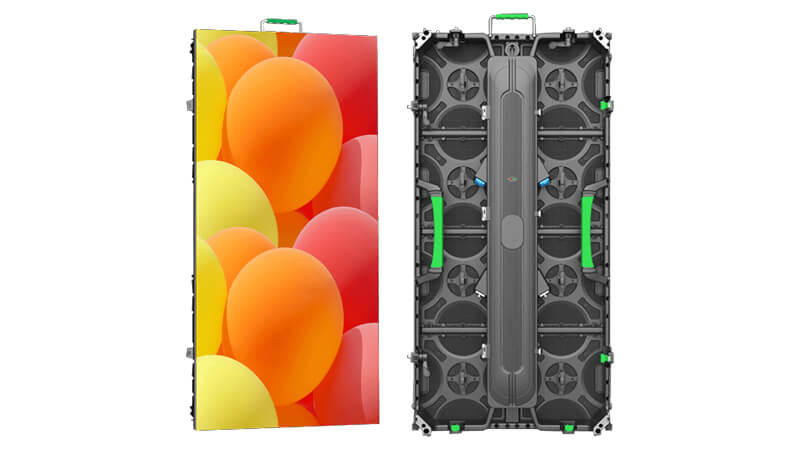
B. LED Modules
Common pixel pitches for rental displays: P2.6 / P2.97 / P3.91. Finer P1.25 / P1.56 / P1.95 are also available.
High-quality SMD LEDs with consistent binning ensure uniform color and brightness.
Front or rear accessibility options allow for quick module replacement without disassembling the video wall.
C. Electronics and Controls
Embedded receiver cards within each cabinet ensure stable data distribution.
Transmitter cards/processors (HDMI/DVI/SDI/DP inputs) provide scaling, switching, and test modes.
High refresh rate driver ICs (≥3840Hz, even 7680Hz) ensure stable images. Pre-wired, labeled cable harnesses standardize power and signal routing.
D. Suspended and floor installation
Truss and hanging bar suspension installation with safety points.
Ground-stacking brackets for venues without rigging capabilities.
Curved and 90° options allow for creative setups (convex/concave/inside and outside corners).
E. Power and Data Cabling
Aviation-grade power cable with locking connector.
Shielded CAT6/EtherCON or proprietary data cable for performance environments.
Spare patch cables included for redundancy.
F. Logistics and Protection
Foam-lined flight case (each cabinet holds 6-8 cabinets, depending on size).
Desiccant and anti-static packaging for moisture and static protection.
Checklists and labels (cabinet ID, chain of custody) to streamline preparation and installation.
4) Choose an LED video wall package based on event requirements
Every venue and performance has its own unique constraints. Adjust your LED video wall package based on the following variables:
A. Indoor events and exhibitions
Prioritize fine-pitch (P1.5 / P1.9 / P2.6 / P2.97) for close viewing distance and clear text; brightness levels of 600-1200 nits are generally sufficient.
B. Outdoor stages and festivals
Choose outdoor P2.6 / P2.97 / P3.91 / P4.81 for longer viewing distances and high brightness of 4500-5000 nits, ensuring clear daytime viewing and protection from sudden rain.
C. Creative Scenario
Ensure your cabinet supports curved locking or 90° rotation for immersive designs; confirm processor capacity to handle unusual pixel graphics.
D. Pro Tip
Whenever possible, use 500×1000mm cabinets to save costs and set up faster; however, using 500×500mm cabinets is lighter to set up and can accommodate unusual aspect ratios.
E. Pixel Pitch and Viewing Distance (Rule of Thumb)
Pixel Pitch Ideal Viewing Distance Typical Applications
P2.6 2.5-5 meters Indoor conferences, exhibition booths, TV studios
P2.97 3-6 meters Indoor concerts, fashion shows, brand events
P3.91 4-8 meters Outdoor stages, city squares, festivals
P4.81 5-10 meters Sports fields, large outdoor gatherings
How to choose: If most attendees are within 4-6 meters of the screen, P2.6/P2.97 is the ideal choice. For larger venues or outdoor lawns, P3.91/P4.81 is more cost-effective and provides sufficient image clarity.
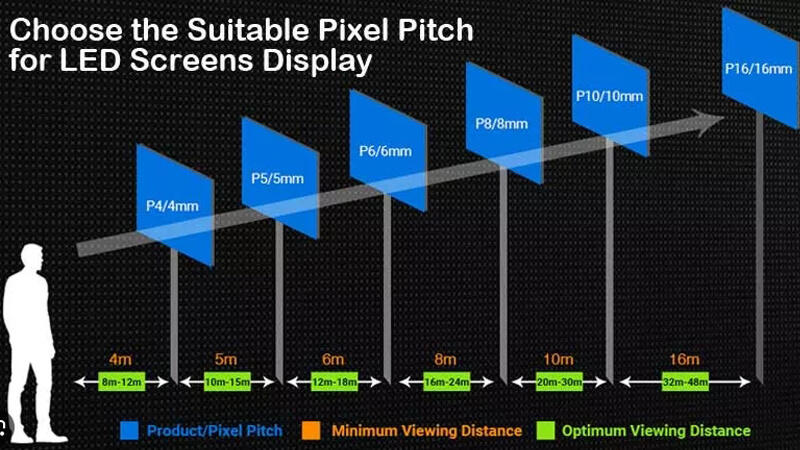
F. Cabinet Weight, Rigging Load, and Ergonomics
Lighter cabinets (500×500 size approx. 6 kg, 500×1000 size approx. 12 kg) reduce stress and speed up installation.
Rear handles, positioning pins, and corner guards reduce falls, finger injuries, and mask bending.
G. Power and Heat
Determine the actual circuit size based on the maximum power consumption of the screen (the average power consumption of mixed content is usually about 1/3 of the maximum power consumption).
Ensure ventilation behind the LED wall and verify whether additional cooling is required in hot climates.
H. Processing Power and Redundancy
Confirm the processor's pixel capacity (total width × height) and input flexibility.
For mission-critical programming, plan for redundant data paths and carry backup processors.
6) LED Video Wall Package Procurement Process
A smooth procurement process follows this predictable path:
1. Define the brief: screen size (aspect ratio), pixel pitch, indoor/outdoor, rigging method, and voltage.
2. Receiver Package Proposal: Define each component—cabinet, video processor, rigging, chassis, spare parts, training, and shipping costs.
3. Factory Pre-configuration: Color calibration, cabinet mapping, quality control, and burn-in testing. Request a pre-shipment video.
4. Logistics: Coordinate shipping methods (air freight for urgent trade shows; sea freight for large fleets), insurance, and customs documentation.
5. Training and Handover: Remote demonstrations, manuals, and wiring diagrams.
6. Budget Recommendation: Add 5% spare modules, backup power supplies, and additional receiving cards to your initial order; this can pay off in the event of cancellations or trade show delays.
7) LED Video Wall Kit Installation and Setup
A. Truss Hanging
1. Preparation: Assemble all necessary accessories for the event, including screens, video processors, distribution boxes, cables, etc. Check locks and connectors.
2. Installation: Attach the boom to the truss using rated shackles; confirm load limits and safety ropes.
3. Erection: Starting from the top row, connect the cabinets using quick-lock locks; check the flatness of the joints during installation.
4. Wiring: Route power and data cables into clean, vertical bundles; mark both ends; and secure any slack.
5. Testing: Power on each section incrementally; load a test pattern; and verify normal display.
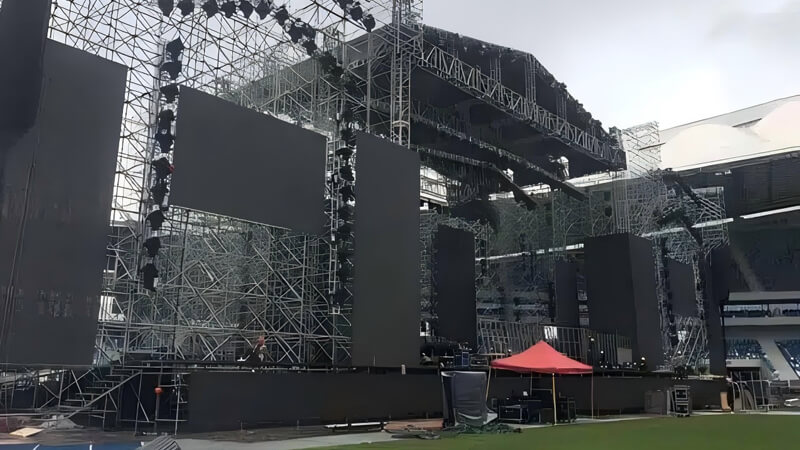
B. Ground Stacking
1. Base: Level the ground stacking frame; use anchors or ballast if necessary.
2. Stacking: Build the columns upward; add rear supports as height increases.
3. Securing: Check verticality and levelness; secure the brackets every 2-3 meters.
C. Commissioning and Content
Calibration: Match brightness/white balance to ambient conditions; save day/night presets.
Playback: Test all input sources, frame rates, and program cues; verify backup paths.
D. Disassembly and Packing
Power-down protocol: Disconnect data connections first to avoid hot-plug spikes.
Gently clean the modules; pack by serial number so that rows and columns stay together during the next build. Record any damaged modules in the maintenance log.
8) LED Video Wall Kit Maintenance and Lifespan
Routine Inspection: Check Position
After each performance, inspect the lampshade, frame, and corners; check for bent covers or loose connectors.
Cleaning: Use a low-pressure air brush or anti-static brush; do not use liquid cleaners unless approved by the manufacturer.
Firmware and Configuration Files: Maintain consistent processor and receiving card firmware across the entire fixture set; maintain consistent documentation versions.
Storage: Store packaging in a dry, climate-controlled space; add desiccant in humid areas.
Spare Parts Management: Rotate spare modules to ensure uniform color aging within inventory.
9) Case Study - LED Video Wall Kit Application Examples
Case 1: Music Festival Main Stage (Europe)
A production company deployed a P3.91 outdoor LED video wall kit for a three-day open-air music festival. Despite intermittent rain, the crew, primarily using 500×1000 mm cabinets, erected a 150-square-meter LED wall in less than seven hours. The system's IP65 rating and 3840Hz refresh rate ensured smooth playback of sponsor loops and live footage. Organizers reported zero visual interruptions for all 12 headlining news groups.
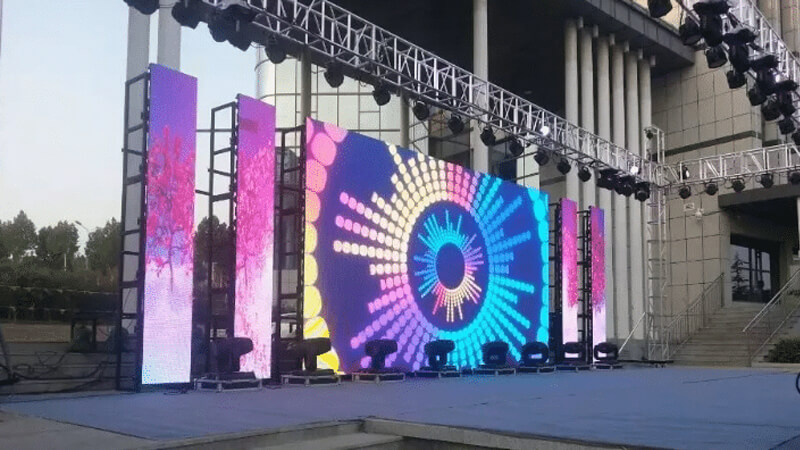
Case 2: Global Tech Conference (Southeast Asia)
For a CEO keynote presentation broadcast live globally, the AV team selected an 8×4 meter indoor P2.6 LED video wall system. Fine pitch ensured crisp UI demonstrations and clear code on slides; processor presets enabled quick switching between laptops and live cameras. The client raved about the image uniformity—no color shifts were visible even in close-ups—and reordered the system for their developer summit.
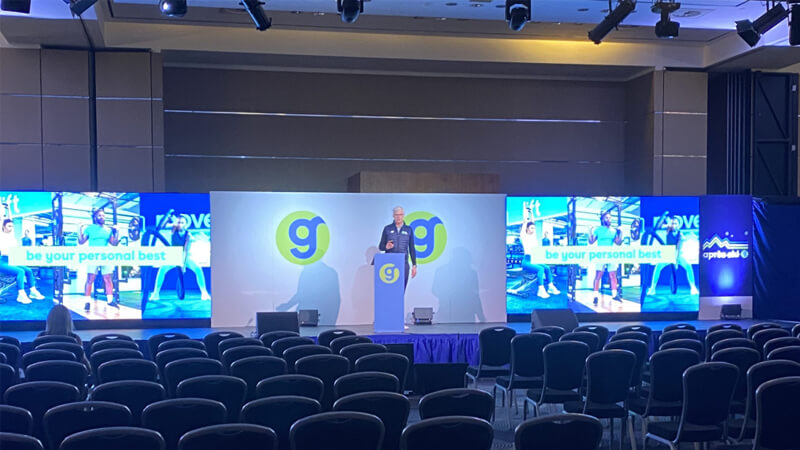
Case 3: Regional Sports Championship (Middle East)
The P3.91 outdoor kit served as a temporary scoreboard, clearly visible even from 100 meters away in direct sunlight. The ground-stacked light boxes were ballasted to withstand gusty winds. Pre-labeled power and data harnesses allowed for daily disassembly and rebuild across the venue in less than three hours, ensuring reliability even with tight schedules.
10) Why Choose Singheng's LED Video Wall Kit
Choosing the right partner is just as important as selecting the right specifications. Here are some reasons why customers choose Singheng's LED video wall kit:
Proven rental experience. With over 10 years of LED manufacturing experience, Singheng's designs are built with road conditions in mind—die-cast aluminum cabinets, quick-lock locks, corner guards, rear handles, and rigging accessories speed setup and reduce damage.
Turnkey kit, not a parts list. From the P2.6/P2.97/P3.91/P4.81 cabinet to the processor, rigging pole, ground stack, flight case, and labeled cables, the Singheng package is delivered ready for touring.
Camera Friendliness. High refresh rates (up to 3840Hz) and stable color calibration ensure flicker-free, uniform images from both the LEDs and cameras—critical for image quality and live broadcasting.
Outdoor Reliability. For outdoor performances, the Singheng kit features IP65 front protection and a weatherproof design (face shield, seals, and ventilation system) to ensure smooth performances rain or shine.
Fast Logistics and Documentation. A clear bill of materials (BoM), wiring diagram, cabinet ID, and pre-shipment test video mitigate risk. Flight cases and foam layouts are optimized for cabinet sizes (500×500 and 500×1000), so crews can find exactly what they need after the show.
Customization and OEM. Need a branded flight case or software splash screen? Singheng supports OEM surface treatments, cabinet labels, and system profiles tailored to your workflow.
Scalable Services. From remote training and commissioning to spare parts strategies (recommended 2-5%), Singheng provides responsive technical support and practical guidance to fleets on every continent.
11) Common LED Video Wall System Mistakes:
Pixel pitch is too small or too large. Too small wastes budget without significant benefit; too large makes text illegible. Pitch should be adjusted based on typical viewing distances.
Ignoring actual rigging conditions. Verify truss capacity, point loads, and wind direction maps as early as possible. For ground stacking, confirm the number of counterweights and ground levelness.
Ignoring redundancy. A single power or data cable failure could cause program interruption. A built-in backup module should be installed.
Blocks, power supplies, and backup signal paths.
Rushed commissioning. Allow ample time for calibration and content testing. Check dimming curves, black levels, and camera flicker before entering the room.
Poor cable management. Unmarked, unprotected wires can cause intermittent failures. Use numbered cable harnesses, strain relief devices, and avoid sharp bends.
12) Future Trends in LED Video Wall Packaging:
Lighter, faster, and more environmentally friendly. The next generation of cabinets aims to weigh less than 5 kg per 500×500 size to reduce labor and lifting loads. Driver IC innovations reduce power consumption without sacrificing visual impact.
The application of flexible rental LED screens is rapidly expanding. Flexible rental LED screens provide greater flexibility and better visual experience for event settings. Curved LED screens are smoother and will not show creases.
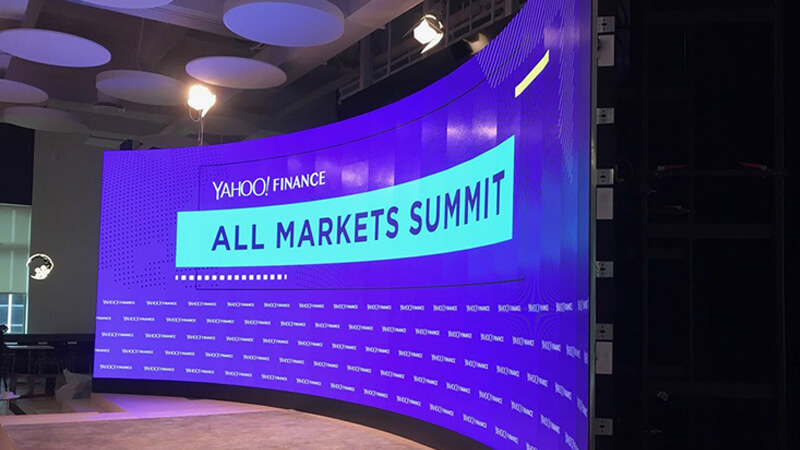
The adoption of Mini LED and Micro LED. More refined light-emitting chips provide higher contrast, deeper blacks, higher clarity, and more refined colors for high-end events.
Hybrid indoor/outdoor designs. Rental companies are increasingly looking for IP65-rated enclosures that can operate in two environments to increase utilization.
Magnetic modules and tool-free maintenance. Faster replacements reduce stage time and ensure tight schedules when every second counts.
Smarter processing. Automatic calibration, HDR workflows, and improved frame rate handling make complex shows easier to program and more immersive.
13) Conclusion – Why an LED video wall package is the best choice for your event
A well-designed LED video wall package can revolutionize production workflows. It simplifies planning, speeds up setup, and delivers broadcast-quality visuals that audiences and cameras will love. Partnering with a manufacturer who understands the realities of rentals will ensure a reliable, flexible, and profitable system for a wide range of performances.
If you're planning a package for the upcoming season, coordinate your venue details and creative goals with trusted supplier Shengheng. Choosing the right LED video wall package means you're not just purchasing LED panels; you're ensuring a seamless performance and exceptional experience.
14) FAQ - LED Video Wall Package (Rental Focus)
1) Can I customize the size and aspect ratio of my LED video wall package?
Of course. The package features a modular design. Using 500×1000mm and 500×500mm cabinets, we can build a standard 16:9 screen for presentations or an extra-wide stage for concerts. Provide a stage drawing or pixel map, and we can pre-plan your package, right down to the number of cabinets and rigging points.
2) Which pixel pitch is best for concerts and festivals?
For concerts with mixed audiences, P3.91 offers the perfect balance between cost, brightness, and viewing distance. For closer VIP seating or IMAG backdrops, P1.95, P2.97, or P2.6 offer higher clarity, especially for cameras and branding, but they require a higher budget.
3) How long does it take to install an LED video wall package?
This depends on the size and rigging equipment, but a well-trained team of 3-4 people can typically set up a 40-60 square meter venue in 3-5 hours using hanging bars, quick-lock locks, and pre-labeled harnesses. Ground stacking may take longer due to the need for leveling and bracing.
4) Can one set be used for both indoor and outdoor events?
Yes, provided you choose an LED video wall package with an IP65 front-facing protection rating and sufficient brightness (≥4500 nits). Many companies include weatherproof P3.91 displays as standard in their product lines. For indoor use, the brightness can be easily dimmed to achieve comfortable viewing conditions. This maximizes the utilization and rental rate of your LED video wall package.
5) How are LED video wall sets shipped and protected?
All cabinets, processors, and rigging are shipped in foam-lined flight cases. The cases can be easily stacked, locked, and rolled through docks and elevators. During humid transport, add desiccant and avoid exposing the cases to direct sunlight or rain during loading.
6) Are special tools required for installation?
Most rental kits are designed for easy setup—quick-lock hooks, hanging rods, and manually adjustable dowel pins. You'll still need common tools (Allen keys, wrenches), safety devices, and rated rigging hardware for trussing.
7) How many technicians are needed to install a medium-sized video wall (e.g., 8 meters by 4.5 meters)?
Plan for 3-5 technicians to smoothly load the system, along with a dedicated video engineer to fine-tune processing, color, and content.
8) How does weather affect outdoor LED video wall kits?
An IP65 rating and proper cable management can effectively handle rain. Wind is a more important factor—establish thresholds (e.g., below or above certain wind speeds), use guy wires/ballast, and ensure your installation plan is signed off by a qualified installer.
9) What is the typical lifespan of a rental LED cabinet?
With proper care and storage, a rental cabinet can last 5-8 years. LED brightness decays slowly; good calibration and module rotation ensures a uniform LED video wall over time.
10) Can you provide training for our staff?
Yes. A reliable LED video wall package should include remote or on-site training on cabinet handling, installation checklists, processor workflow, troubleshooting, and maintenance. Many teams also include a plastic-enclosed quick start guide in the flight case.
11) How many spare parts should I have on hand?
A general rule of thumb is to have 3-5% spare modules, along with a set of power supplies, receiver cards, and cables. For mission-critical performances, bring a spare processor and spare media players. Spare parts are the cheapest insurance you can buy.
12) What kind of warranty and after-sales support should I expect?
Look for a multi-year warranty and responsive technical support, including pre-show inspections, remote commissioning, and parts availability. For multi-regional performances, verify the logistics of replacing modules and power supplies to minimize downtime.
Related Singheng resources: • Rental LED Display (Event) • Rental LED Display RA100 series • Hard Connection RH50 series • All LED Display Products • Contact Singheng for a Quote

